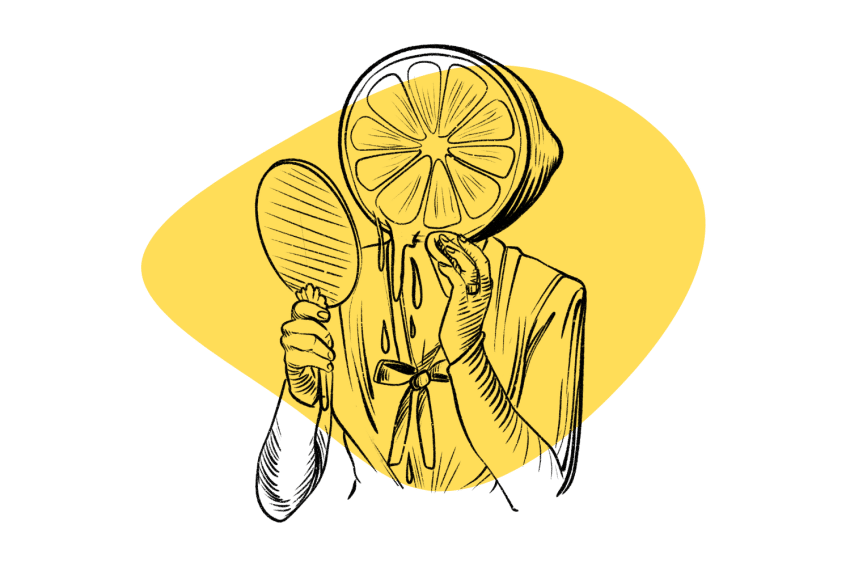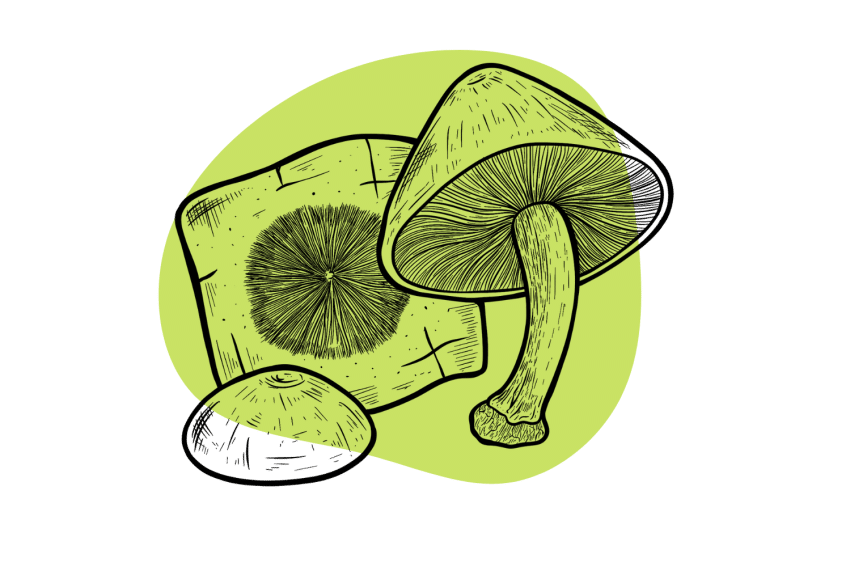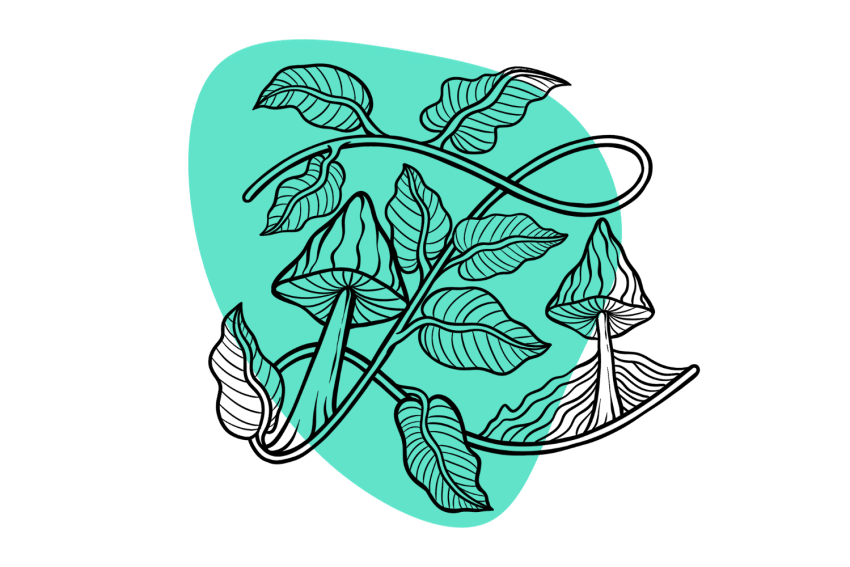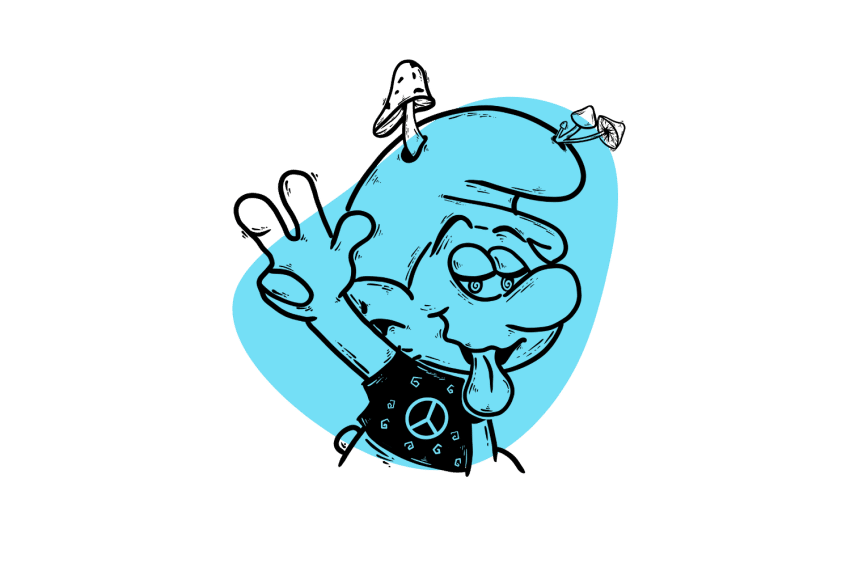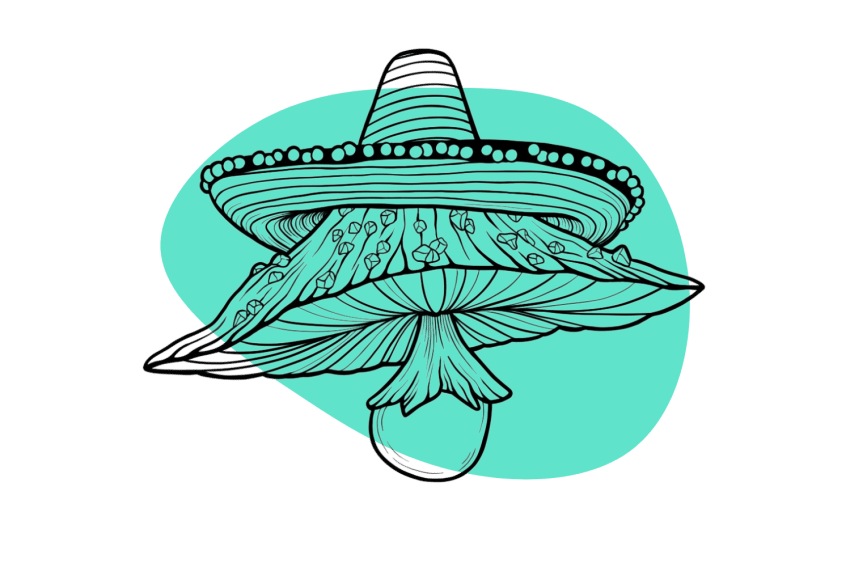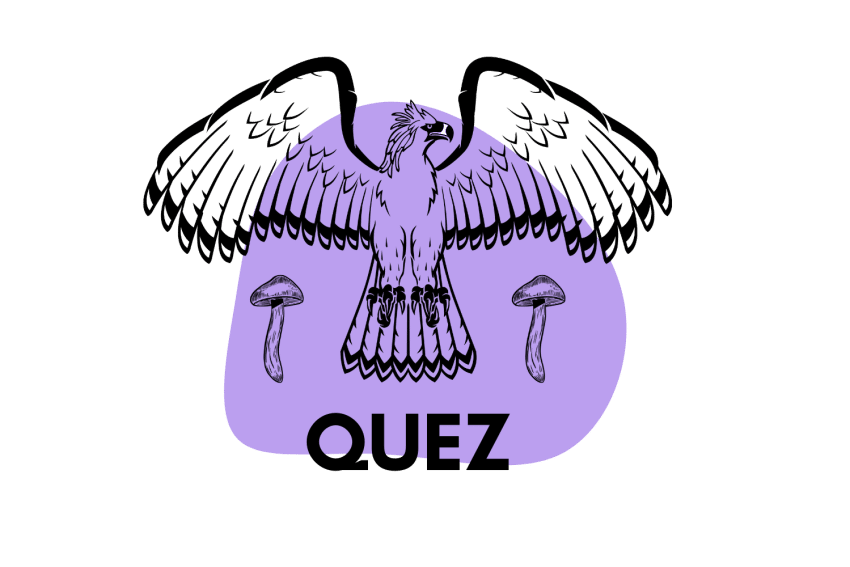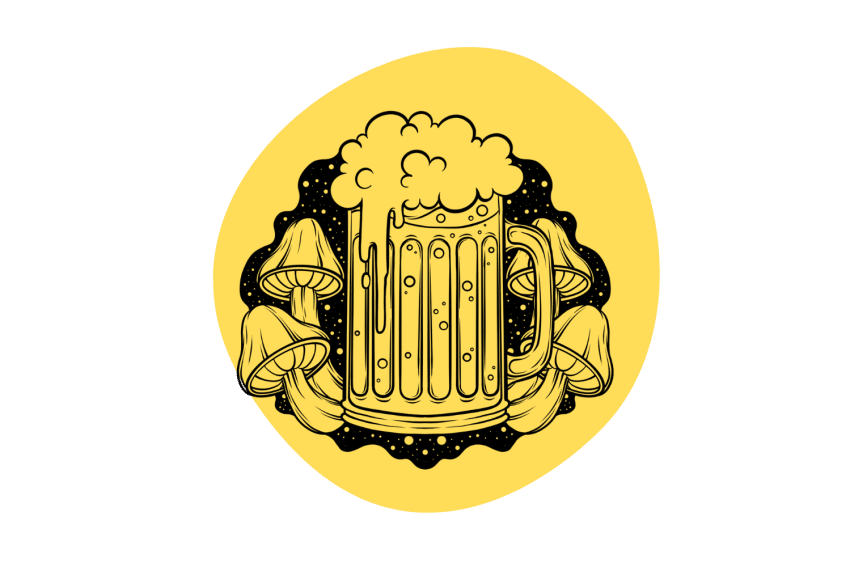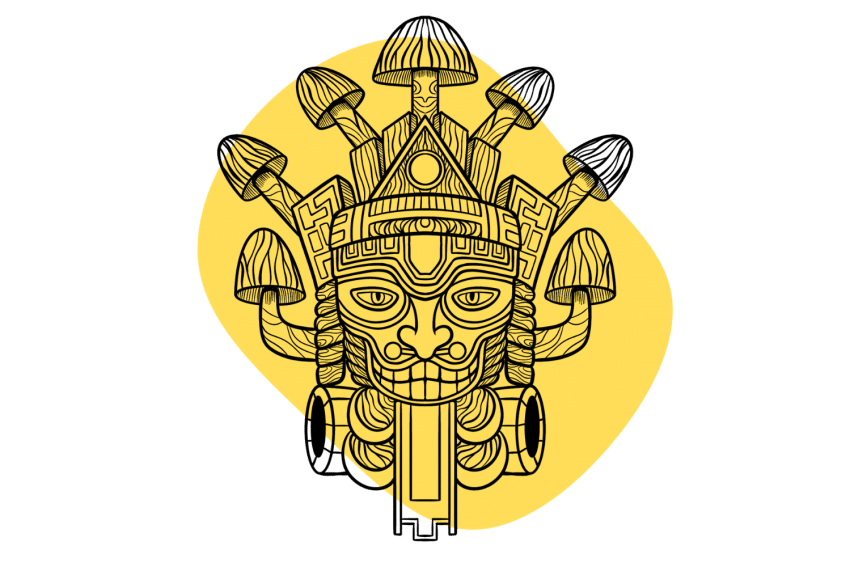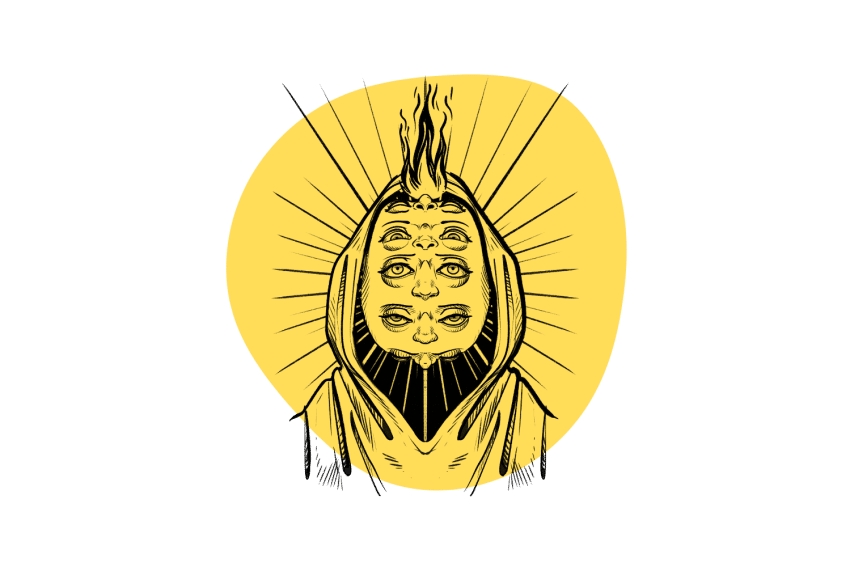Blue Meanies Mushrooms: A Definitive Guide to Panaeolus cyanescens
Panaeolus cyanescens (Blue Meanies) should not be confused with Psilocybe cyanescens or the strain sold as “Blue Meanies.”
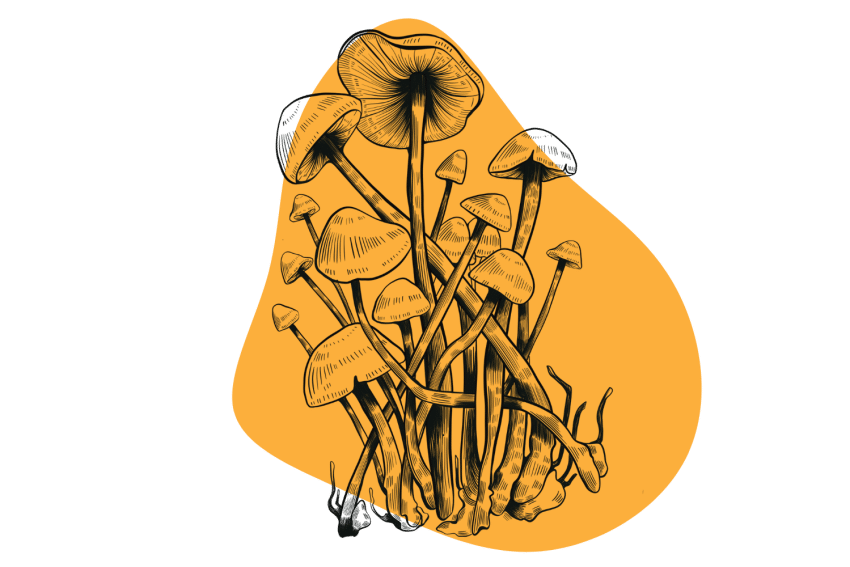
Panaeolus cyanescens, known commonly as “Blue Meanies” mushrooms, is one of the more potent species of psilocybin-containing mushrooms. They’re relatively small and easily go unnoticed by psychedelic mushroom foragers.
This species is the strongest member of the Panaeolus genus but delivers comparable potency to the average Psilocybe cubensis mushroom. Panaeolus cyanescens contains around 0.7% psilocybin and 0.1% psilocin.
Psilocybin is the prodrug for psilocin. Once inside the body, psilocybin is metabolized into the active form, psilocin. Mushrooms like Panaeolus cubensis, which contain high levels of psilocybin, tend to take longer to kick in than mushrooms like Psilocybe cyanescens, which has a much higher psilocin ratio.
In this article, we’ll be looking at:
- What Blue Meanies are
- The confusion surrounding the species
- The history of Panaeolus cyanescens
- The potency of the shrooms
- The dose of Blue Meanies mushrooms
- Where you can find them in the wild
- How to identify the mushroom positively
- How to prepare and store mushrooms that have been harvested
- Looking at the cultivation process for Panaeolus cyanescens
We’ll also be touching on the legalities of this species as well as answering a few frequently asked questions about Panaeolus cyanescens.
What Are Blue Meanies Mushrooms?
Paneulus cyanescens is one of the stronger psilocybin-containing mushrooms out there, despite its relatively unassuming nature. In fact, this species is the strongest psychedelic member of the greater Panaeolus genus.
The mushrooms produced by this species are generally very small and have light gray-colored caps.
Panaeolus mushrooms — often called “mottlegills” due to the patches of color on the gills — are extremely common, but not all species of the genus contain psilocybin. They grow across the globe in several different countries, thrive in various climates, from tropical to temperate, and are capable of fruiting year-round.
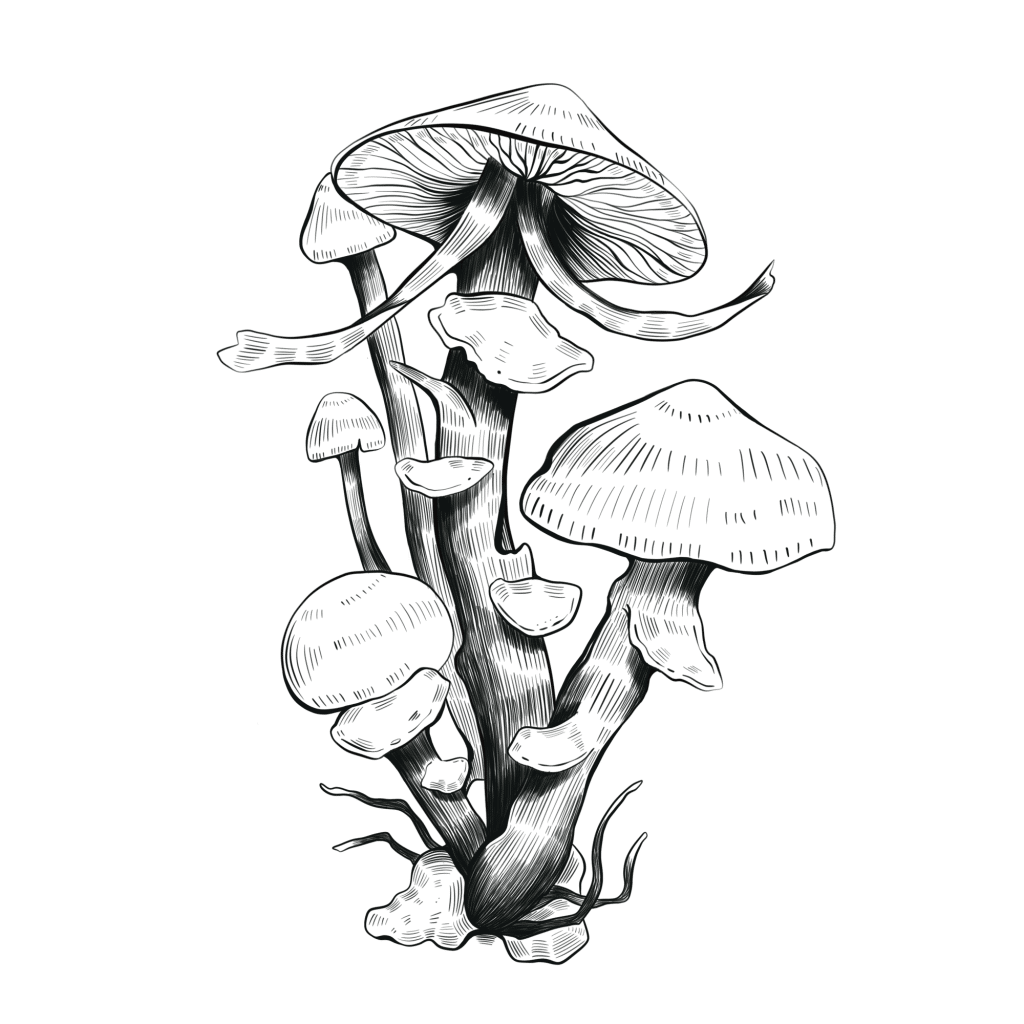
The cyanescens species of the Panaeolus genus can be found growing in grassland, heathland, and open pastures. There are around 13 other species of Panaeolus that produce psilocybin, with P. cyanescens being the most common overall.
This Panaeolus species is a bit of a “freak of nature.” Unlike other psychedelic mushroom genera, such as Psilocybe, Panaeolus species don’t normally produce psilocybin or psilocin. It’s believed that Panaeolus cyanescens started producing these tryptamines through bacterial gene transfer from nearby Psilocybe mushrooms. Both Panaeolus cyanescens and many Psilocybe species thrive in the same environments (grasslands and pastures).
This mushroom isn’t popular with home growers because it produces a much lower yield than Psilocybe cubensis and tends to be pickier in terms of growing conditions. This mushroom is better for the wild forager than the DIY cultivator.
The best place to find this mushroom is in manure left behind by grazing animals. They can be hard to spot, but once you’ve found a patch, it’s a jackpot because they tend to pop up in dense clusters containing several hundred mushrooms.
Addressing the Confusion Surrounding Panaeolus cyanescens (AKA “Blue Meanies”)
The many names of this mushroom have caused a lot of confusion in the past.
The proper taxonomic name of this species is Panaeolus cyanescens. “Panaeolus” comes from the Greek word meaning “all variegated” — describing the genus’ mottled or spotted texture and coloration. The species name “cyanescens” is derived from the Greek word “cyaneus,” which means blue — describing the color the mushroom’s flesh shows once bruised.
Before the current binomial name was developed, the species was recognized as “Copelandia cyanescens” — some taxonomists still use this name today. This causes a lot of confusion because it sounds like the species is of an entirely different genus, which, of course, it’s not.
The confusion doesn’t stop with taxonomic names. Another unique species in the Psilocybe genus — Psilocybe cyanescens — is often confused with this species. Abbreviated, Psilocybe cyanescens is “P. cyanescens,” and Panaeolus cyanescens is “P. cyanescens” — you can see why people may confuse the two entirely different species.
But there’s more…
The most frequently used common name for Panaeolus cyanescens is Blue Meanies. The “Blue” part of the name comes from the color the mushroom bruises when damaged, and the “Meanies” part of the name describes their potency.

There are a few theories on where this name came from. Some believe it came from the “Blue Meanies” in the classic Beatles film “The Yellow Submarine,” and others assume that it came from the Australian slang term that has been used to describe magic mushrooms in general.
What’s confusing about this common name is the fact that other species can be described with it. In popular culture across the globe, the name “Blue Meanies” is often used to describe several varieties of psilocybin-containing mushrooms. There’s also a strain of Psilocybe cubensis known as “Blue Meanies,” further adding to the name conundrum.
Some people may also know this species by the common name “The Hawaiian,” which causes further confusion with another strain of Psilocybe cubensis called “Hawaiian.”
The History of Panaeolus cyanescens
The first written account of Panaeolus cyanescens was by Berkeley and Broome in 1871 [1]. It was identified from a sample from Sri Lanka and named “Agaricus cyanescens.”
Later, in 1887, it was scientifically listed as Panaeolus cyanescens by P.A. Saccardo [2]. Panaeolus cyanescens is the recognized taxonomic name we use today. However, when Singer named the species “Copelandia cyanescens” in 1951, the name stuck for several years — some still use it today [3].
The Copelandia genus was deprecated — this essentially means that it became invalid. All the species listed under the Copelandia genus were replaced by the name Panaeolus.
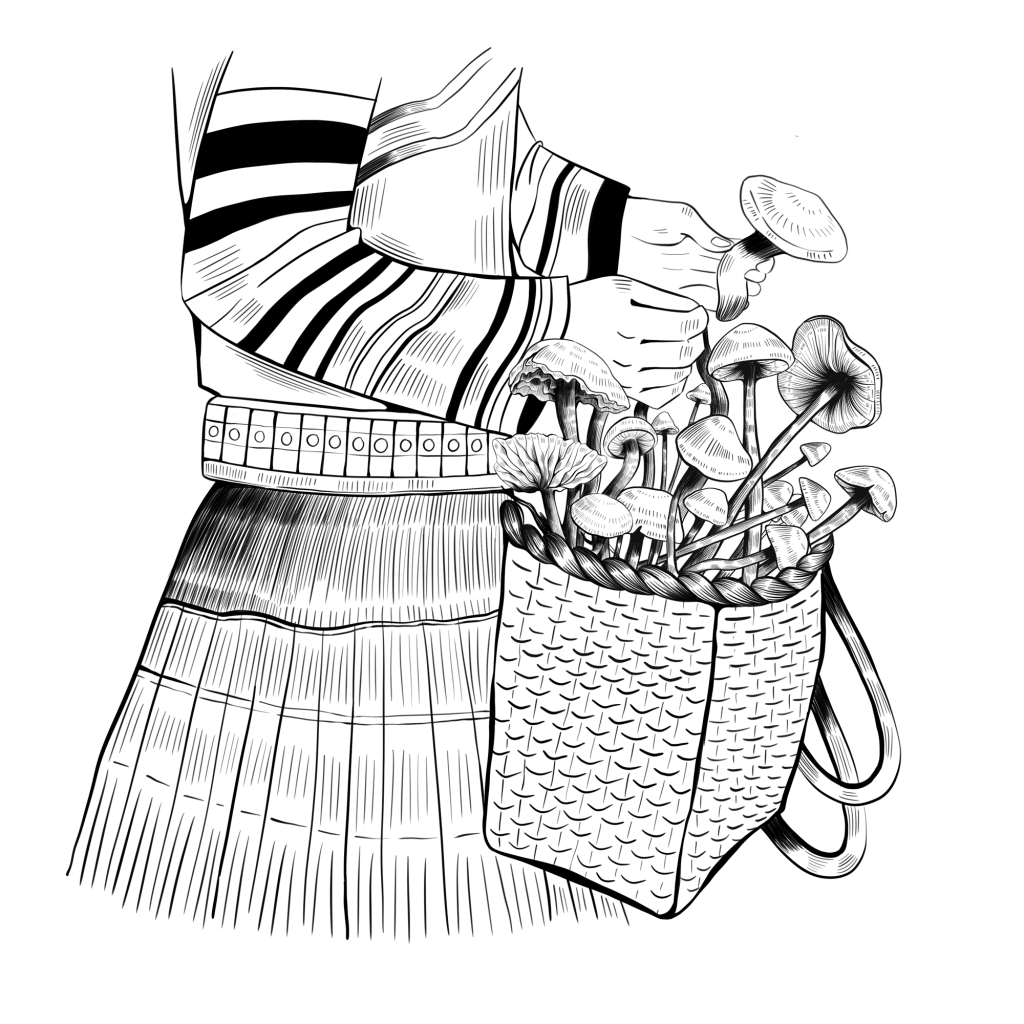
This species goes further back than its taxonomic classification. Panaeolus cyanescens is believed to have originated in Asia. The mushroom likely spread across the globe through spore transfer through the agricultural trade.
Sometime during the 1800s, cattle with the species’ spores in their fodder or manure were imported to Hawaii from the Philippines. From here, the spores likely traveled through similar trade to the mainland of the United States.
It’s believed the species was also similarly transported to Europe. Supposedly, a group of racehorses transported Panaeolus cyanescens spores into southern France from Indonesia.
The Potency & Effects of Panaeolus cyanescens
Panaeolus cyanescens is a notoriously potent species of psychedelic mushroom — don’t be fooled by its small stature.
Many people claim that this species’ shrooms contain two to three times the amount of psilocybin than the average Psilocybe cubensis strain — though this may not be entirely correct.
In the early 1960s, Albert Hofmann — famous for being the first person to synthesize LSD (lysergic acid diethylamide) — analyzed this species, then known as Copelandia cyanescens [4]. Hofmann himself reported that these mushrooms contain far larger quantities of psilocin than psilocybin.

Here’s why this is significant.
Psilocin is bioactive in humans, whereas psilocybin is not. The body must metabolize the psilocybin and turn it into psilocin — this is why the effects can take some time to kick in, and the peak of the psychedelic trip is “delayed.”
With higher levels of psilocin than psilocybin, fresh Panaeolus cyanescens have a faster onset of effects and a more sudden come-up.
Most studies involving this mushroom suggest its potency varies significantly. For example, a 1992 study by T. Stijve found Panaeolus cyanescens’ potency to be highly variable [5]. Stijve discovered that the average potency fell between 0.17 to 0.95% psilocin and 0.16 to 0.19% psilocybin (dry weight).
Based on the levels identified by T. Stijve, the average Psilocybe cubensis mushroom would likely be more potent — contrary to what many people report. In comparison, Psilocybe cubensis tends to have a psilocybin content of 0.5–1% and a psilocin content of 0.14–0.42% (dry weight).
Although P. cubensis may produce similar psilocybin levels, the species doesn’t seem capable of producing as much psilocin. This is likely why much stronger effects are reported from Panaeolus cyanescens than from Psilocybe cubensis.
What’s the Dose of Panaeolus cyanescens?
The potency of freshly harvested Panaeolus cyanescens is notoriously hard to gauge. It’s difficult to recommend a specific dose of these mushrooms because 1 gram from one harvest could be equivalent to 3 grams from another batch.
Most sources recommend taking a specific number of caps of Panaeolus cyanescens as a dose — but this is even less helpful. Not only are you faced with the intense variability of individual mushroom potency, but you’re also faced with the issue that not all mushroom caps are even the same size.
With that said, we’ve done our best to quantify the dose as much as possible here — but it’s important to keep in mind there is no hard-fast rule here. Every mushroom harvest is going to produce different experiences.
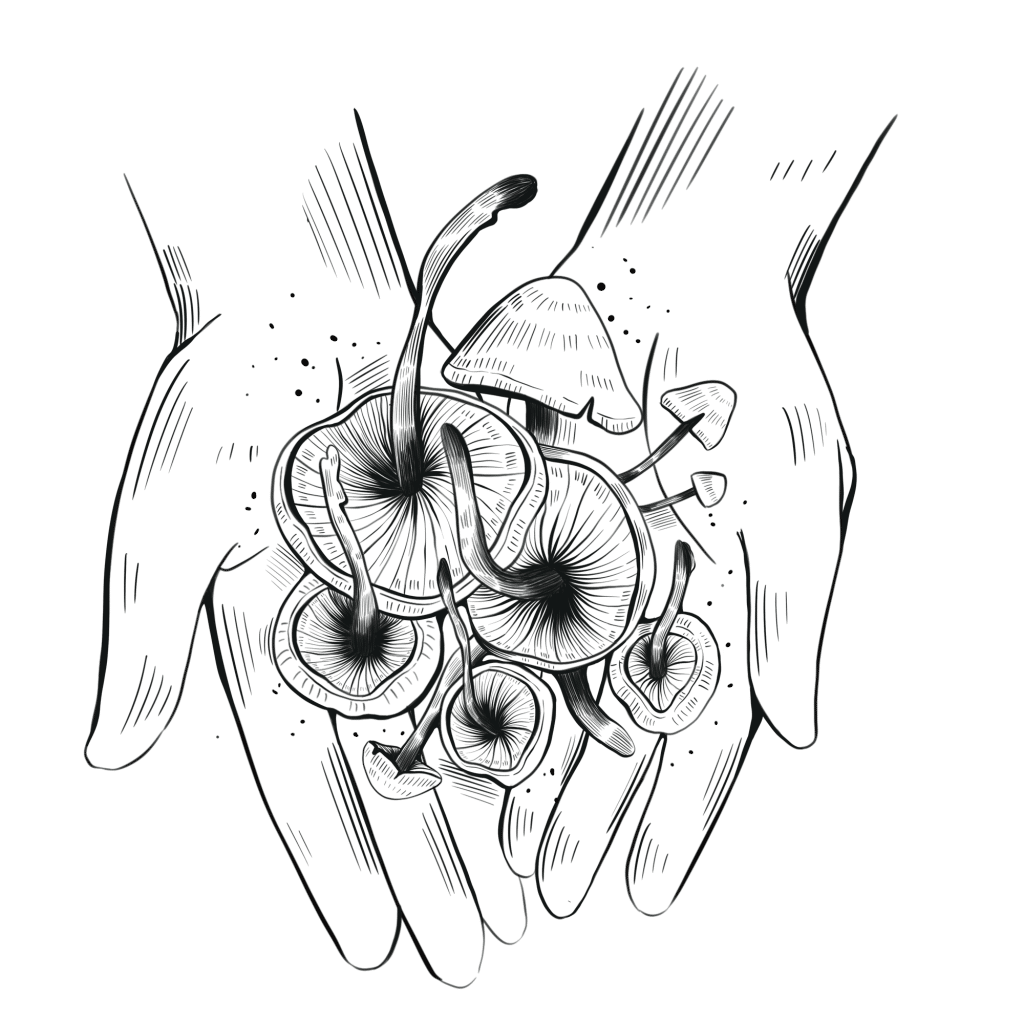
In general, if using dried mushrooms, you’ll want to go for a 20% higher dose than you would with Psilocybe cubensis. This means that for a standard 3-gram dose equivalent of Psilocybe cubensis, you should use about 3.6 grams.
If using the fresh mushrooms, you’ll need to do essentially the opposite — use about a 20% lower dose of Panaeolus cyanescens than you would with Psilocybe cubensis. This takes into account the increased psilocin levels in the fresh mushrooms.
Magic Mushroom Dosage Calculator
Double-check the potency of the DXM you’re using, and look for the addition of other compounds such as acetaminophen which can cause severe liver-toxic side-effects at this dose.
Dosage guide for Psilocybe cyanescens:
- Microdose: 0.1–0.5 grams
- Standard: 1–2 grams
- Strong: 2–4 grams
- Heroic: 4+ grams
How Many Caps Should I Take?
We strongly recommend using the weight of your mushrooms for dosing instead of the caps. However, there are a lot of people out here that prefer dosing “by the cap,” so we’ll cover the philosophy behind this as well.
In general, you’ll want to stick with a small number of fresh mushrooms — somewhere around 5 to 10 medium-sized caps. When dried, this works out to 1 or 2 grams. Fresh, this is about 8 to 15 grams.
Wait an hour or so to gauge the effects. If you feel like you still want more to reach your desired level, eat another 1–5 caps and repeat. Don’t go overboard with this mushroom — especially while fresh.
Can You Microdose Blue Meanies?
Despite their high potency, Panaeolus cyanescens mushrooms are great for microdosing.
A microdose is a sub-perceptual dose that’s low enough not to induce any psychedelic effects. You can microdose with any psychedelic substance, but the most popular substances are “classic psychedelics,” such as psilocybin, LSD, and DMT.
A microdose may induce feelings of mild euphoria, body energy, and “crisper” vision, but you shouldn’t experience any hallucinatory effects that affect inhibition.
People often microdose psilocybin to improve mood, optimize focus, and induce a creative thought process. Many people working in the creative field (writers, artists, designers, etc.), as well as people with ADHD, report an increase in focus and the ability to concentrate for longer periods. People with anxiety or depression have also reported improvements in mood from microdosing.
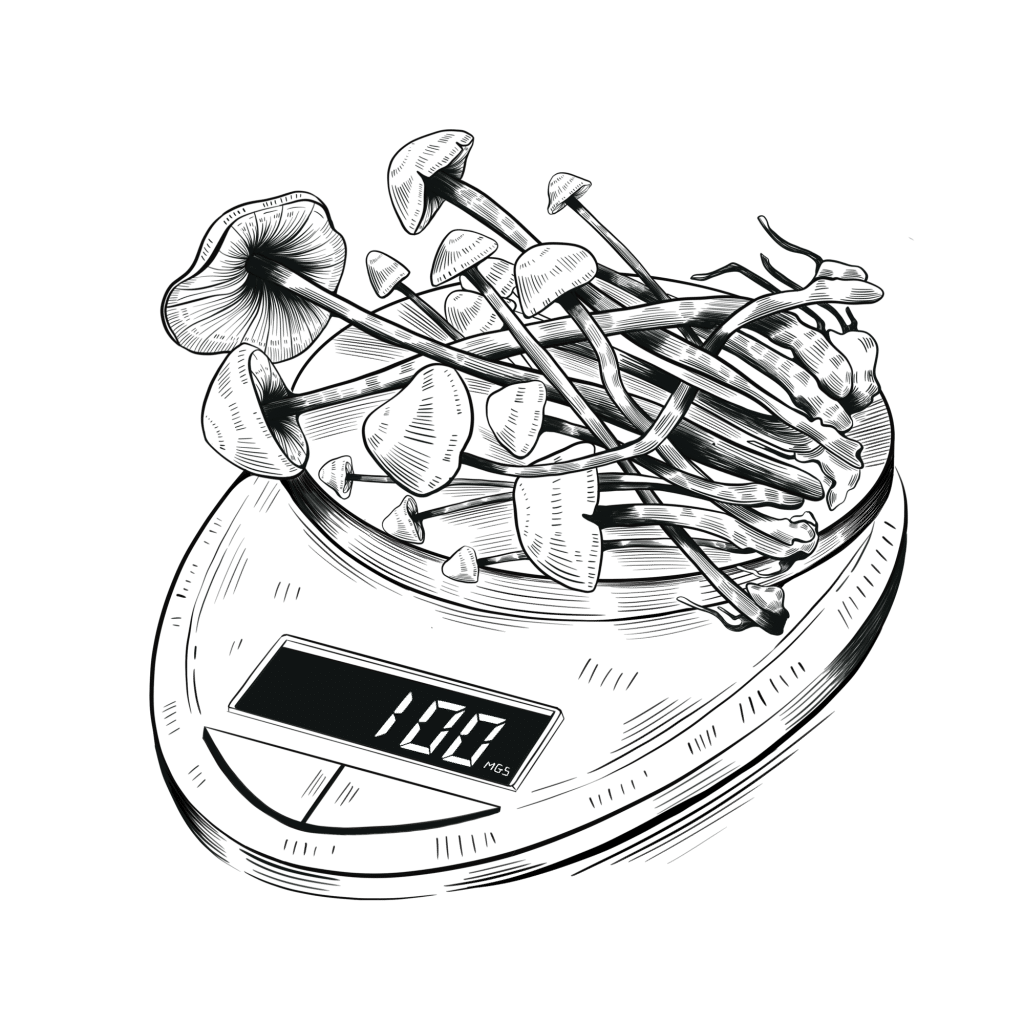
There’s no right or wrong way to microdose Blue Meanies mushrooms. What’s important is taking enough to induce the potential positive effects you’re looking for without inducing a psychedelic trip. Most people consume around 50 to 100 milligrams of psilocybin in the form of dried mushrooms. A dose in this range is usually taken every three or four days.
If you choose to microdose Panaeolus cyanescens, do so in a controlled environment the first few times to ensure you don’t induce any hallucinatory responses. Once you’re certain the dose isn’t affecting you, go ahead and resume “normal life.”
Where Can You Find Panaeolus cyanescens?
Panaeolus cyanescens is a grassland species that thrives in manure. It’s believed the species originated in Asia, but now it grows in fields across the globe, particularly in the dung of livestock in grazed pastures in warm climates.
Unlike many other mushroom species, Panaeolus cyanescens doesn’t tend to fruit during the autumn months.
Where you can find Panaeolus cyanesscens:
- In tropical climates, this species grows year-round.
- In sub-tropical climates, the mushrooms grow from late spring to early autumn (depending on rain and humidity levels)
- In temperate regions, they grow during the summer in periods of high humidity and rainfall.
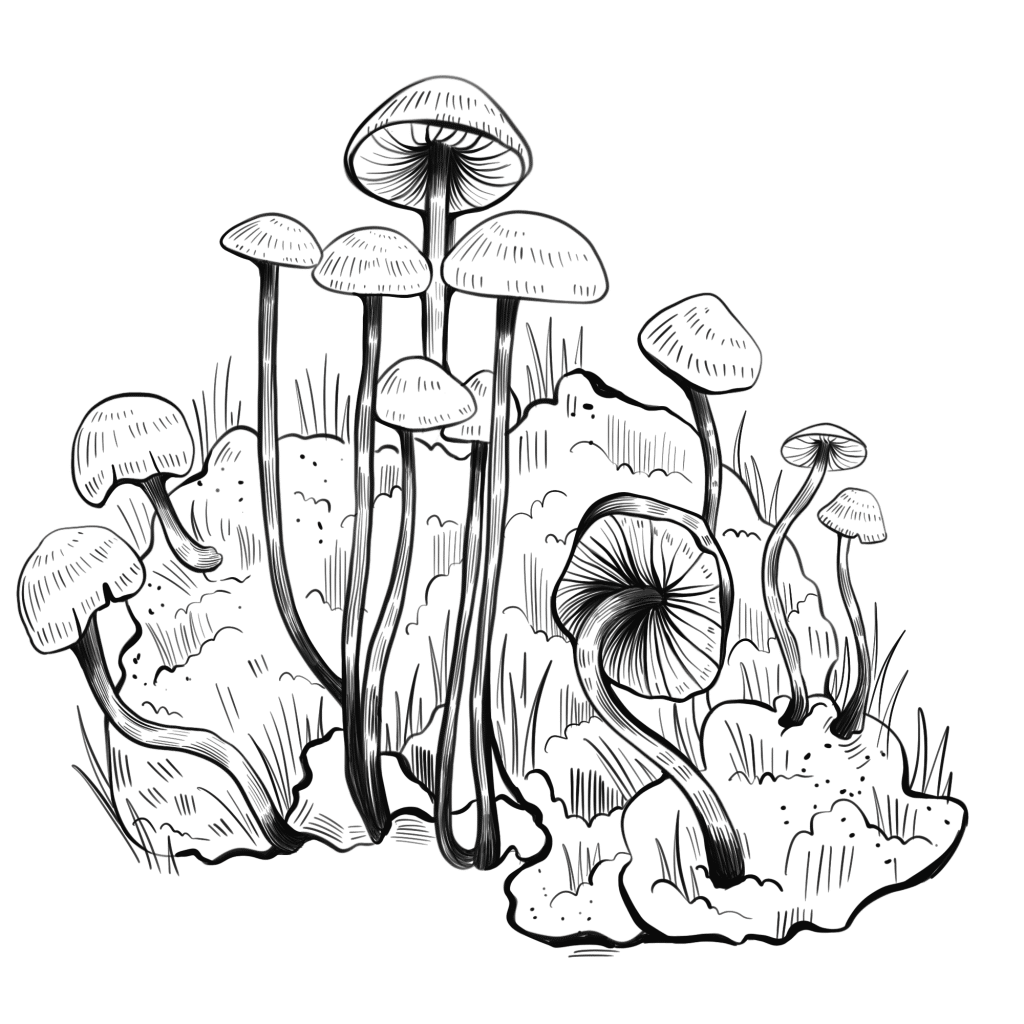
Most Panaeolus cyanescens samples are collected from cattle or horse manure in open pastures and grazed fields. They do tend to grow in clusters but also grow singly.
The best chance of finding this species is during periods of humidity after moderate to heavy rainfall. Cattle or horse pastures on the edges of woodlands are good areas to begin the search. Check “cow pats” and horse manure for the fruiting fungus, but don’t ignore areas without any visible manure.
What Countries Do Blue Meanies Grow In?
Panaeolus cyanescens grows mostly in tropical and subtropical climates but does well in temperate regions as well. This species is native to Southeast Asia. However, its spores have traveled far and wide across the globe through livestock trading between Asia, Europe, America, and Australia.
This species can now be found on all four corners of the globe, primarily in the Southern Hemisphere but occasionally in the Northern Hemisphere. It’s believed the spores reached the more temperate regions of the Northern Hemisphere through the importation of livestock from warmer regions.
Here’s a list of countries where Panaeolus cyanescens (Blue Meanies) grow:
- Australia
- Brazil
- Bolivia
- Bali
- Cambodia
- Colombia
- Costa Rica
- Fiji
- France
- Guam
- Hawaii (USA)
- India
- Indonesia
- Italy
- Malaysia
- Mexico
- New Zealand
- Papua New Guinea
- Peru
- The Philippines
- Puerto Rico (USA)
- Spain
- South Africa
- Thailand
- United States (Florida & the Gulf Coast)
- Vietnam

This species likely grows in several countries that aren’t on the list above because spores are easily transported to different regions through import and export. The list above contains the recognized countries in which P. cyanescens grows.
How to Identify Panaeolus cyanescens
Panaeolus cyanescens mushrooms are an off-white or light gray color when mature. When young, the mushrooms are light brown — this coloration gradually fades away as the mushrooms mature, but some carry brown or yellowish tones through to maturity.
The mushrooms are small compared to many other psilocybin-containing mushroom species. The caps can be as small as 0.5 centimeters and rarely grow larger than two centimeters in diameter. The mushrooms can vary from 7-12 centimeters tall. The gills are tightly-packed and have a speckled black and gray coloration.
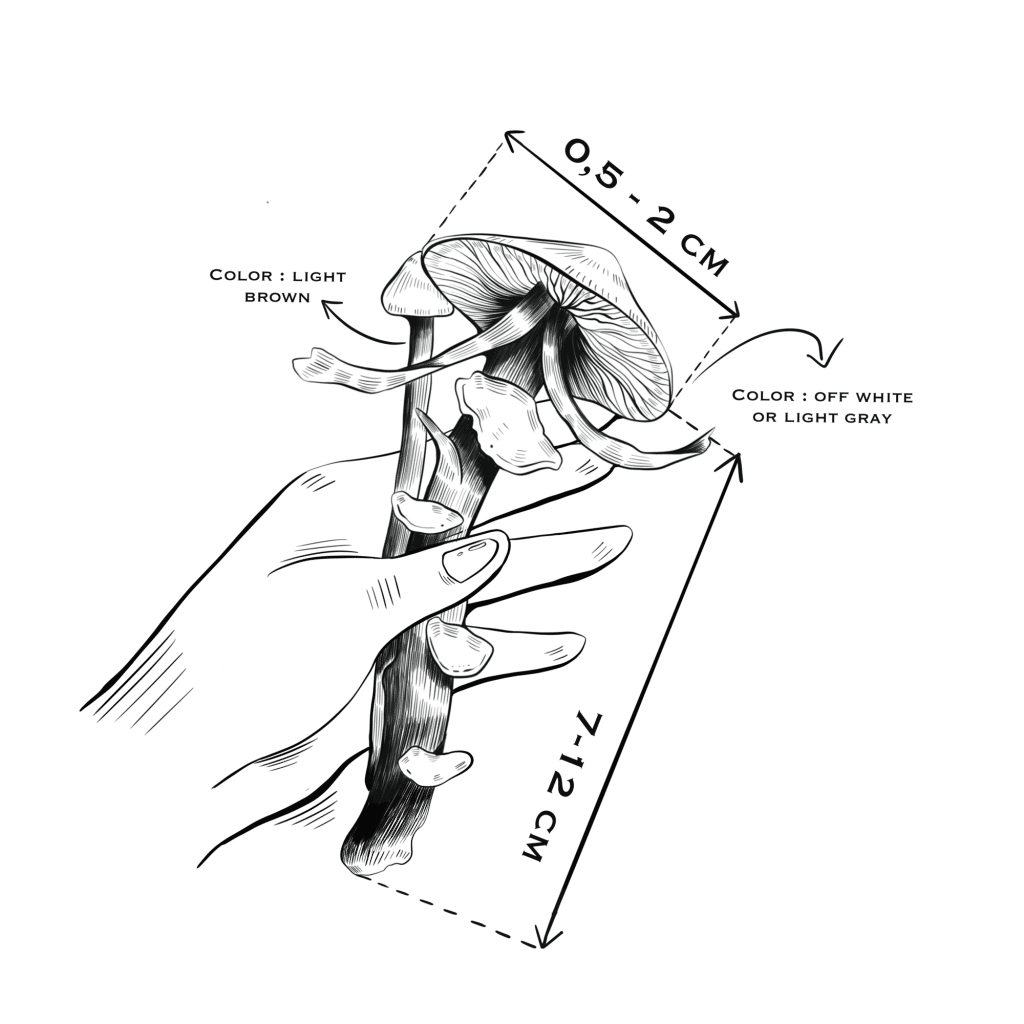
Like most species of psilocybin-containing mushrooms, Panaeolus cyanescens takes on shades of blue when bruised. The stem can be pinched to check this — it takes no more than 10 minutes before the pinched area develops blue hues. This is a good indicator for psilocybin, but it’s not fool-proof — some non-active and poisonous species can also react this way.
This species can be rather difficult to identify because it doesn’t have any “tell-tale” identifiers like other small psilocybin mushrooms, such as Psilocybe semilanceata. If you’re going to go search for them, I recommend purchasing a decent mushroom I.D. guide and contacting an experienced forager before heading into the field.
Here’s a simple features guide for Blue Meanies:
- Cap — Light gray to off-white (mature). Light brown (young). 0.5–2.0 cm in diameter. Hemispheric (half a sphere) when young growing campanulate (bell-shaped) in maturity and slightly convex in older mushrooms. Caps lose a lot of their color as they dry out. Turning almost white with cracks in dry weather.
- Gills — Adnate (mostly attached) to adnexed (slightly attached) to the stipe. Close and “tight-knit” with black or gray coloration and a mottled (spotted or speckled) appearance. This comes as the spores mature unevenly across the gills.
- Stipe (Stalk) — 7–12 cm long and 2–3 mm thick. Thickness is equal from the base to the cap but slightly wider at the vulva (base). Similar coloration to the cap being gray or off-white. Often, the stipe is covered in a fine white powder-like substance. Produces blue hues when bruised.
- Spores — Elliptical and smooth. Black or dark purple.
Panaeolus cyanescens Look-Alikes
Panaeolus cyanescens has several doppelgangers. Many species of Panaeolus look incredibly similar — this can make it difficult to distinguish P. cyanescens from other species within the genus.
The most commonly mistaken Panaeolus look-alike is Panaeolus antillarum. This species is unbelievably similar to Panaeolus cyanescens, and for a long time, the two species were believed to be the same. P. antillarum has a very slightly thicker cap and is macroscopically lighter in coloration.
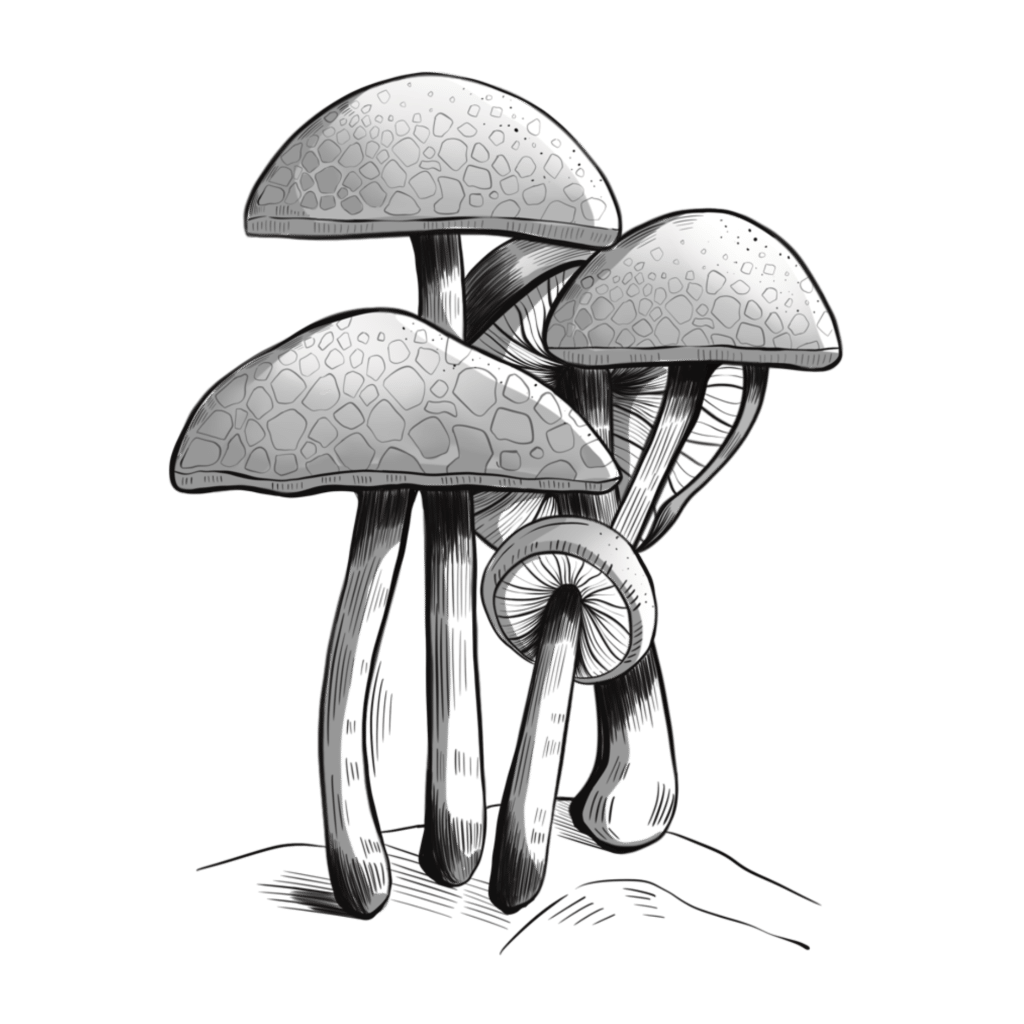
The best way to tell Panaeolus antillarum from Panaeolus cyanescens is to do the pinch test. After the stem has been pinched, if it develops blue hues, it’s not P. antillarum. However, this doesn’t mean it’s P. cyanescens either — other similar species within different genera may also turn blue.
Other species in the Panaeolus genus may also look similar to P. cyanescens, but there are key differences that set them apart.
There are other species in different genera that share similarities with Blue Meanies. Fortunately, most of these species don’t share the same habitat. Many look-alike species grow in different substrates, such as wood chips, logs, or soils.
When searching for Panaeolus cyanescens, it’s wise to look around manure in pastures rather than in areas that could cross over into the habitats of similar-looking mushroom species. If you learn from an experienced forager and have a good field guide for your area, you’ll be able to tell this species apart from its look-alikes.
Here are some of the common look-alikes that can be confused with P. cyanescens:
- Protostropharia semiglobata
- Pholiotina rugosa
- Tubaria furfuracea
- Conocybe (species within this genus)
- Deconica (species within this genus)
- Pholiotina rugosa (deadly but does have distinct differences)
I’ve mentioned this before, but it’s extremely important that you know how to I.D. this mushroom with 100% accuracy before foraging. Ask an experienced forager to help you and, at the very least, get a good mushroom identification guide and a field book of your local area.
How to Prepare & Store Panaeolus cyanescens Mushrooms
Panaeolus cyanescens mushrooms are small in size and don’t contain much water. This makes them incredibly easy to prepare, dry, and store. Like other small psilocybin species such as Psilocybe semilanceata (Liberty Caps), Blue Meanies can be quickly dried without much equipment.
You don’t need a dehydrator to dry these mushrooms effectively.
Once you’ve harvested a bunch of Panaeolus cyanescens mushrooms, you can clean them off using a small artist paintbrush and lay them out on a sheet of paper out of direct sunlight for drying.
Spread the mushrooms out so they aren’t touching each other, and turn them over every few hours so they dry evenly. The mushrooms may become stuck to the paper if you don’t turn them regularly enough.
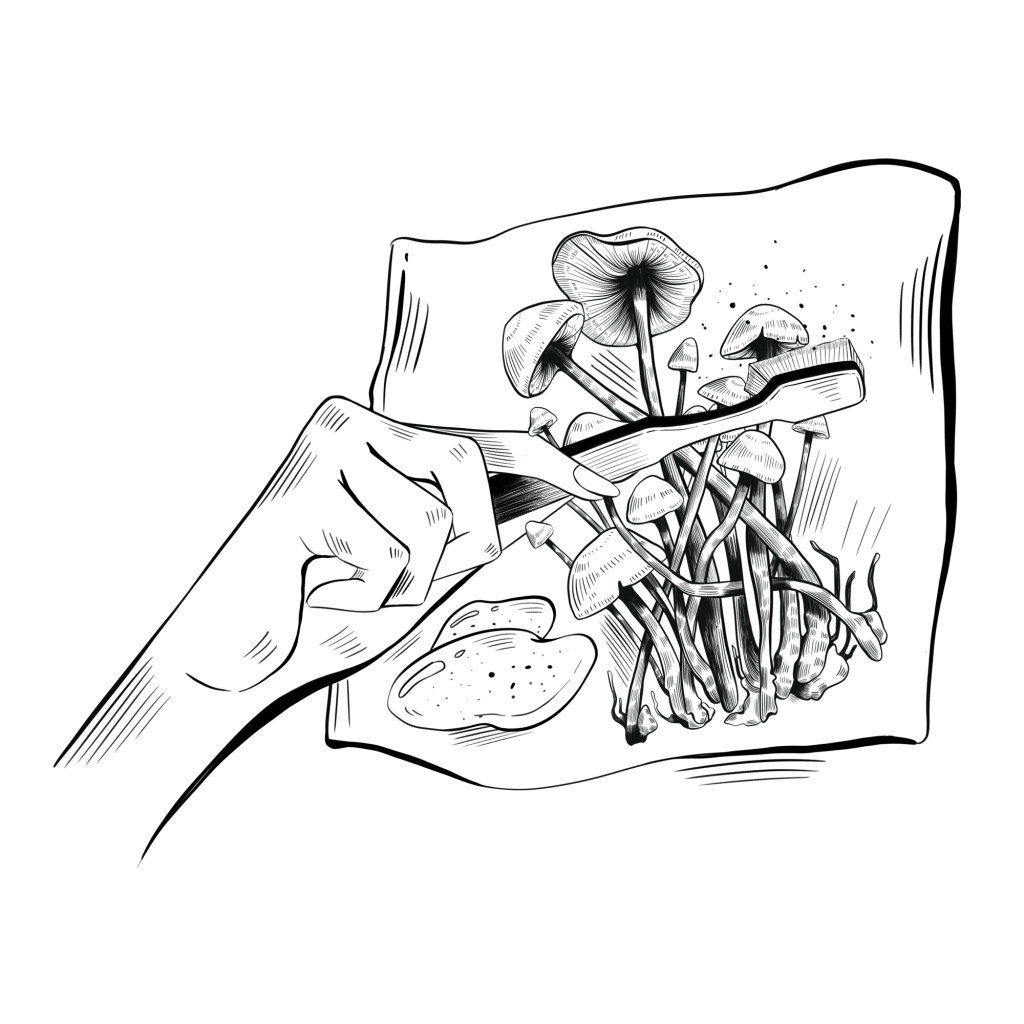
You can tell when the mushrooms have completely dried by doing the snap test. If the caps crumble when pinched and the stems snap cleanly, the mushrooms are dry enough to store.
To ensure that the dried shrooms stay moisture-free and don’t begin to mold, store them in an air-tight jar with a small packet of food-safe silica. Silica is an astringent — a substance that sucks moisture from its surrounding environment. Storing the shrooms in this way will give them the longest shelf life.
Keep the jar in a cool dark place out of direct sunlight to ensure that the mushrooms hold on to as much potency as possible for as long as possible.
Light and heat can degrade psilocybin over time which will ultimately lead to weaker magic mushrooms. Even in complete darkness, the mushrooms will eventually lose potency. However, if you store them well, they should retain much of their psilocybin and psilocin for up to two years or more.
Can You Cultivate Panaeolus cyanescens?
It’s possible to cultivate Panaeolus cyanescens both outdoors (depending on where you live) and in an artificial environment indoors. They are a bit more challenging to grow than Psilocybe cubensis mushrooms, but someone with experience growing mushrooms shouldn’t have any issues.
Panaeolus cyanescens requires a decent cultivation setup, and a lot of care and attention is needed to ensure the growing environment stays stable. This species can be susceptible to mold growth during the incubation phase, so inoculation must be performed in the most sterile way possible.
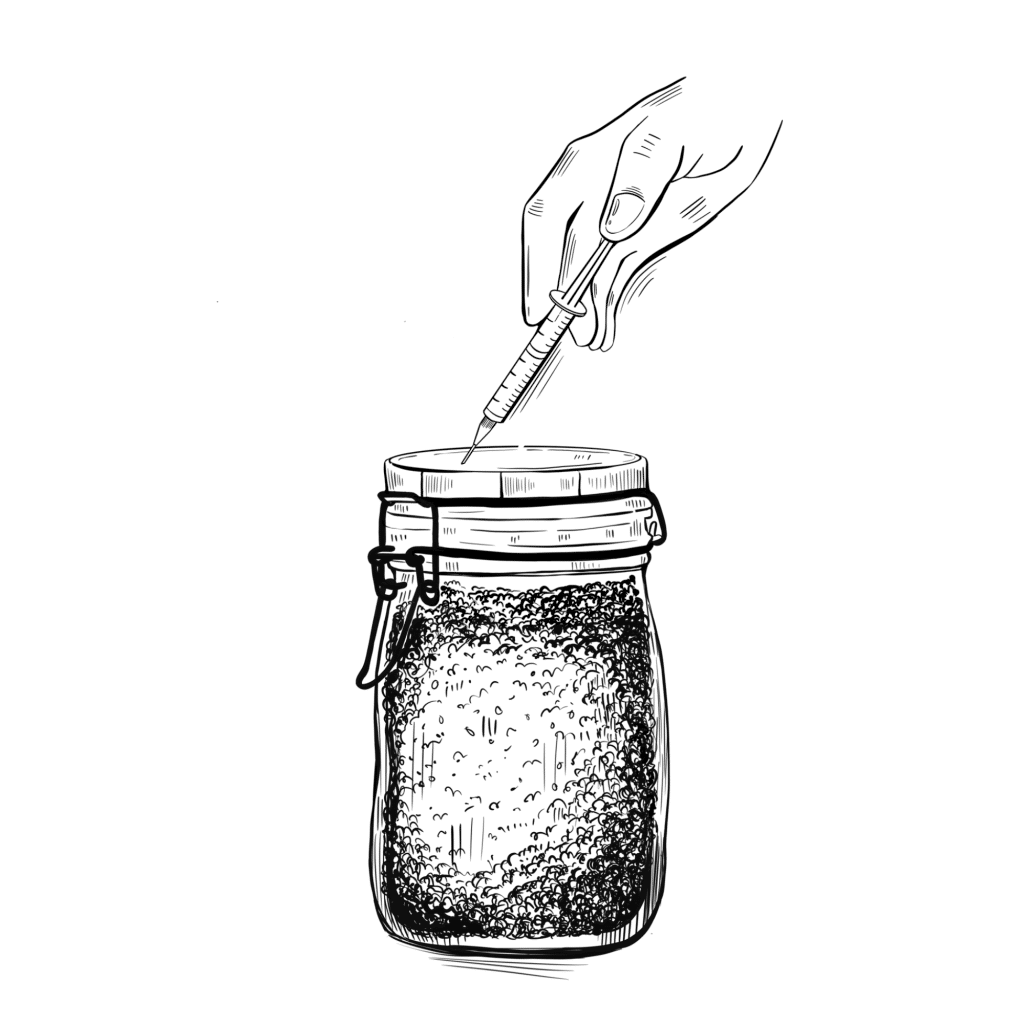
These mushrooms don’t colonize or grow as fast as the typical P. cubensis strain. It takes patience to see a Panaeolus grow through to the end. It takes longer for the substrate to become colonized with mycelium. This species also takes twice as long as P. cubensis to produce mushrooms when the mycelium is exposed to fruiting conditions.
These long incubation and fruiting times often cause a grow to go downhill. The longer these stages take, the more chance there is of contamination. Cleanliness is essential if you’re to have success with this species in an artificial environment.
People who have good experience growing Psilocybe cubensis and follow sterile practices religiously may want to take on the challenge of cultivating this species. I wouldn’t recommend this for the beginner who perhaps hasn’t (or produced very few) cultivated mushrooms of other species.
How to Grow Panaeolus cyanescens
As mentioned, Blue Meanies can be challenging to grow, but that’s not to say they’re impossible to cultivate in an artificial environment. These mushrooms can be grown in the same way as Psilocybe cubensis. The only difference is that environmental conditions must be monitored and regulated more closely.
The easiest way to grow Panaeolus cyanescens is by using PF-Tek, which involves the inoculation of sterile substrate-filled jars, an incubation phase, and a fruiting phase. It’s quite a simple process, and if you’re looking at cultivating this species, you probably already know what PF-Tek is.
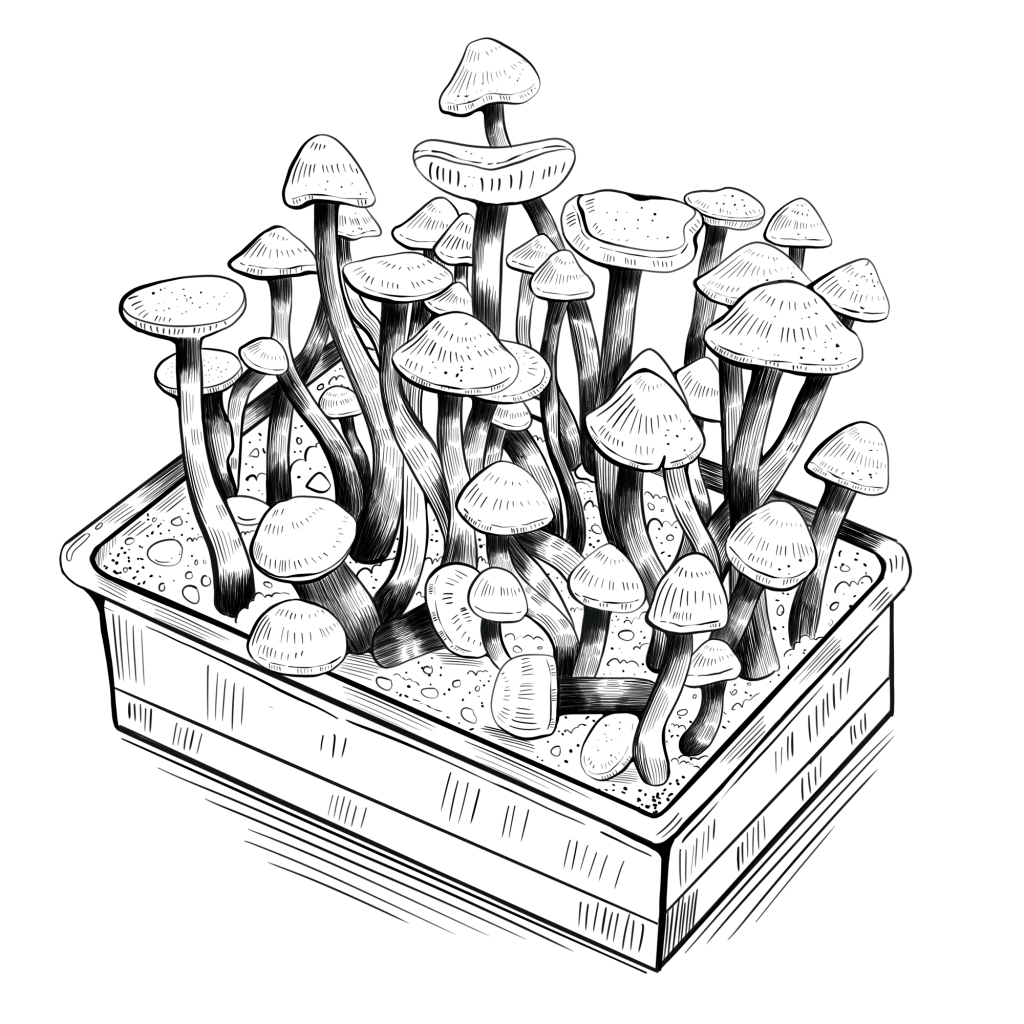
For those who are less experienced, here’s how to perform this cultivation method:
First, fill some glass jars with a growing substrate. Pasteurized manure is the best option for this dung-loving species, but good results can be had on rye grain or coco-coir and vermiculite.
Once the jars are filled, they must be sterilized — this can be achieved with the use of a pressure cooker. Once sterilization is complete, the jars are left to cool. After this, they’re ready for inoculation.
The best way to inoculate the jars is by using a sterile spore syringe. Panaeolus cyanescens spore syringes can be purchased from a variety of vendors, such as SporeWorks (U.S. and Canada) or The Magic Mushrooms Shop (U.K. and Europe).
The needle of the syringe must be sterilized with the heat of a flame. Once cooled, the needle can be used to inject the spores into the substrate. The jars are then sealed and left to incubate. A simple incubator can be made using a box, water, and an aquarium heater. During incubation, the environment should be kept between 20ºC-28ºC (68–82ºF).
Incubation takes around two weeks, but potentially longer for this species. The jars are ready for fruiting when the substrate is completely white with mycelium.
When the jars are ready for fruiting, the resulting mycelium cakes can be placed in a fruiting chamber — a simple ventilated box with a heat mat placed underneath to control temperature. Humidity is controlled by spraying the inside of the container with water.
The internal environment of the fruiting chamber should be kept somewhere between 26℃ -28℃ (79℉-82℉) for Panaeolus cyanescens and other subtropical shrooms.
After a week or so in the fruiting chamber, the first “pinheads” (small mushrooms) should begin to appear — don’t touch these, as they can stop growing. As the mushrooms mature, you can harvest and dry them for storage.
This was a very basic rundown of the cultivation process. To find out how to perform this technique properly, check out this mushroom cultivation guide.
Are Blue Meanies Mushrooms Legal?
These mushrooms are illegal in most parts of the world. There are a few U.S. states (Colorado and Oregon), as well as a few local municipalities (such as Ann Arbor, Berkeley, and San Francisco, just to name a few), that have decriminalized psilocybin-containing mushrooms, however.
In Canada, psilocybin mushrooms have been decriminalized in Vancouver, British Columbia, as well as Toronto, Ontario — but they remain strictly prohibited in the rest of the country.
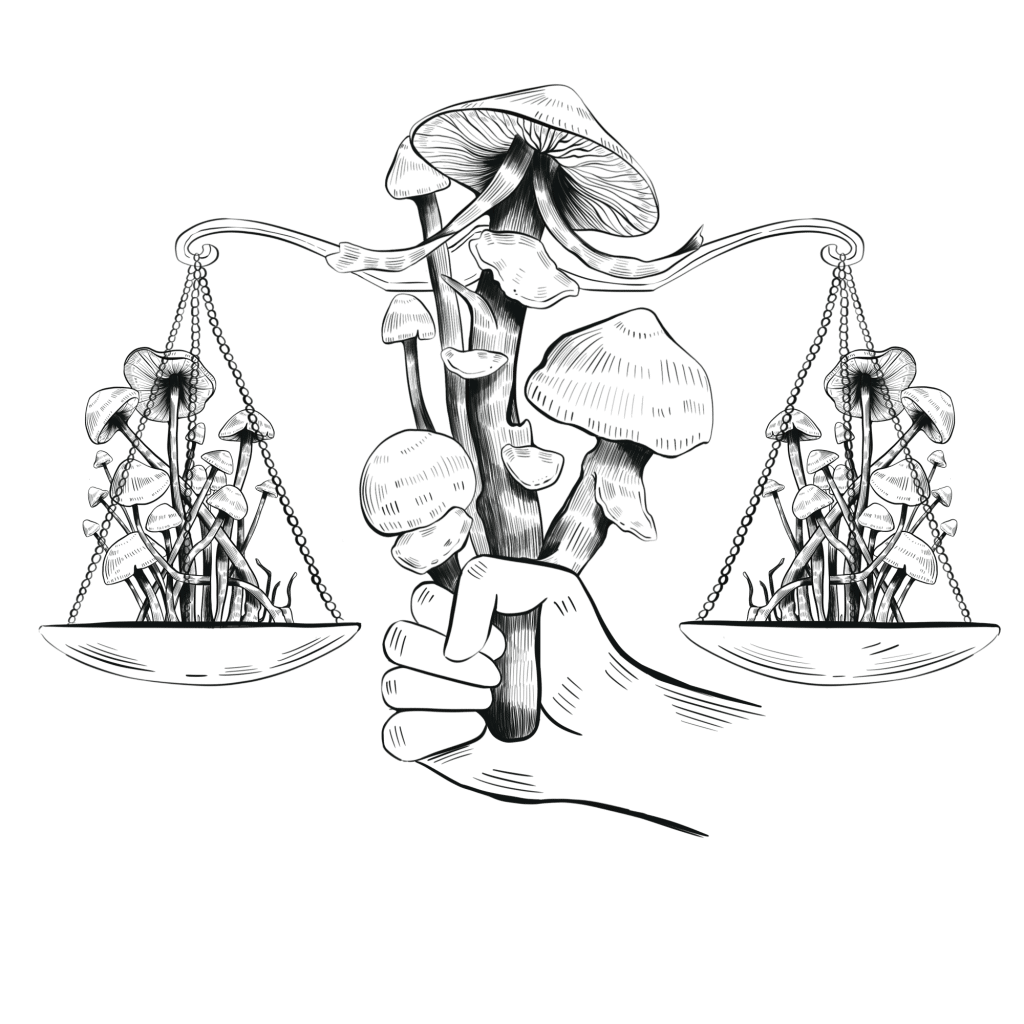
In several countries, such as the United Kingdom, it’s even illegal to pick mushrooms that contain psilocybin from the ground. Be careful if you decide to go in search of these shrooms in the environment surrounding your place of residence. Be sure to check the laws surrounding psilocybin in your country before going foraging for psilocybin-containing fungi.
Frequently Asked Questions About Panaeolus cyanescens
1. Why Aren’t All Panaeolus Species Psychedelic?
There are over 100 recognized species in the genus Panaeolus, but only 13 contain psilocybin and psilocin — which is quite unusual. When you look at other genera, such as Psilocybe, every species has psilocybin and/or psilocin — even if it’s at low levels.
It’s believed that mushrooms produce psilocybin to protect the reproductive fruits from potential predators.
When an animal or insect eats the mushroom, the psychoactive alkaloids induce toxicity and discourage (at the very least) the predator from eating any more of the fungi. Species in the Psilocybe genus developed this defense long ago, and now, every recognized Psilocybe species contains the compounds to some degree.
Panaeolus is a peculiar genus in the fact that very few species within it contain these tryptamines. It’s theorized that some Panaeolus species obtained the ability to produce psilocybin and psilocin through gene transfer. We see mushrooms above ground, but their “body” is the mycelium that lies beneath the earth’s surface.
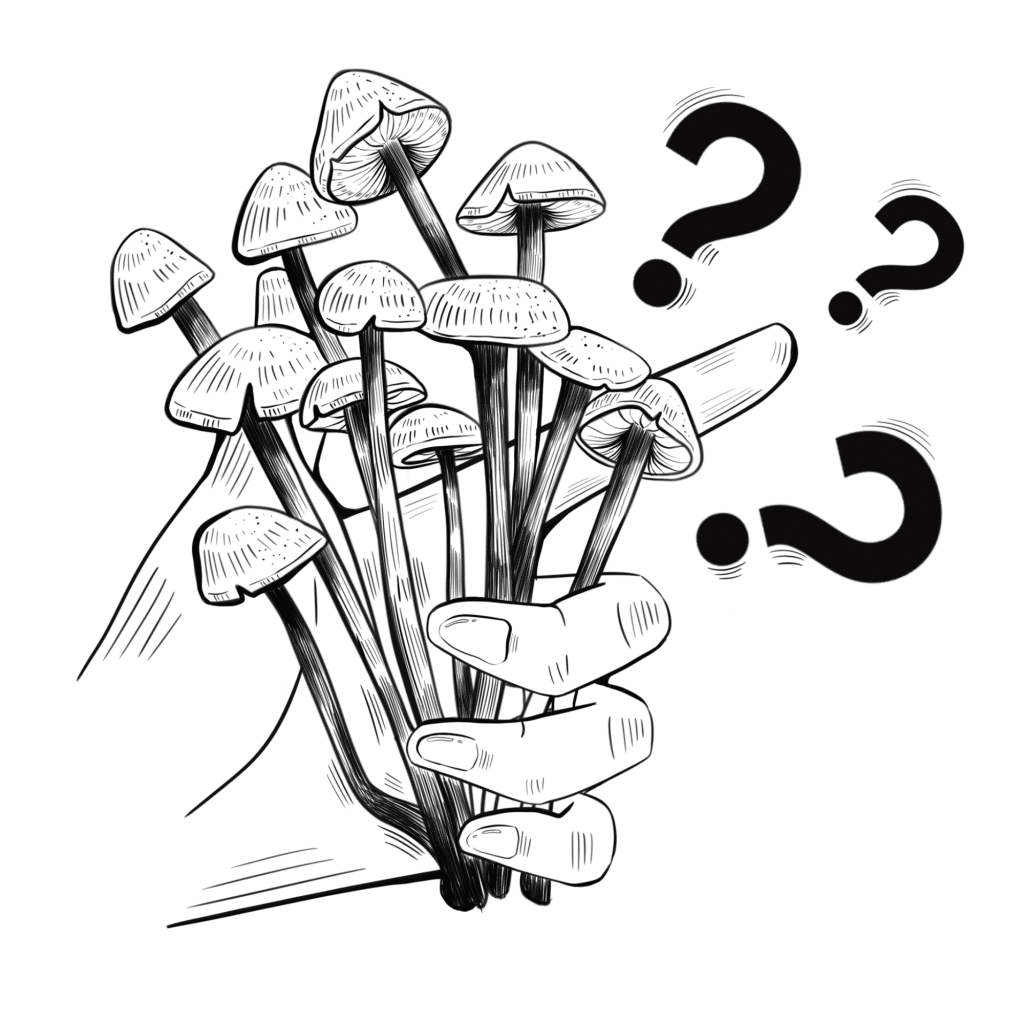
It seems that Panaeolus species that share habitats with Psilocybe species carry psilocybin and psilocin. This may not be a coincidence. It’s theorized that through bacterial transfer, Psilocybe species growing nearby have transferred some of their genes through mycelium networks to certain species of Panaeolus that share the same habitat and substrate.
These Panaeolus species — P. cyanescens being one of them — have retained these Psilocybe genes and continue to produce psilocybin and psilocin regardless of where they now grow.
It’s not fully understood how this works or whether or not it is the reason that few Panaeolus species produce the compounds, but it’s the most convincing and realistic theory.
2. Can Panaeolus cyanescens Cause Addiction or Dependence?
There is currently no evidence to suggest that Panaeolus cyanescens — or any other psilocybin-containing fungi, for that matter — can cause addiction or dependence in the same way that drugs like opioids, benzodiazepines, and stimulants/amphetamines can.
The psychoactive compounds in Panaeolus cyanescens — psilocybin and psilocin — do not activate the brain’s reward system in the same way that drugs of abuse do. The psychedelic effects of these compounds are typically short-lived, and although intense, the effects aren’t particularly desirable — at least in a way that promotes repeated use.
With that being said, like all psychoactive substances, Panaeolus cyanescens and magic mushrooms, in general, can be misused, abused, and excessive or frequent use may lead to negative consequences or adverse effects.
It’s important to use Panaeolus cyanescens and other psychedelic substances responsibly in a safe and controlled setting. Psychedelics can be extremely rewarding when used correctly, but there’s always potential for abuse.
It’s unlikely that a regular person will become addicted to or dependent on these mushrooms. However, someone with addictive personality traits could develop a psychological addiction to psilocybin — I must add that this is rarely reported, and as far as we know, no one has had to undergo rehabilitation for psilocybin use.
Psilocybin may actually help people overcome physical and psychological addictions to more serious substances such as heroin, methamphetamine, benzodiazepines, and alcohol. Studies into the effectiveness of psilocybin in rehabilitation have shown extremely positive results [6].
3. What Other Species of Mushroom Produce Psilocybin?
There are several species of psychedelic mushrooms on the planet — many of which contain psilocybin. There are over 200 species of mushrooms that contain psilocybin. The most commonly known psilocybin-containing mushrooms in the genus Psilocybe.
The Psilocybe genus includes over 100 species — all of which contain psilocybin in some percentage. The most common species in this genus is Psilocybe cubensis — a favorite among mycologists and amateur cultivators because they’re some of the easiest mushrooms to grow.
Within the Psilocybe cubensis species alone, there are over 100 different strains. These genetic variants show differences in appearance, growth characteristics, and potency. Some, such as “Golden Teacher,” are easy to grow and have average potency. Other strains, such as “Penis Envy,” have unbelievably high levels of psilocybin and psilocin.
There are six main genera of mushrooms that contain psilocybin-producing mushrooms:
- Psilocybe
- Panaeolus
- Conocybe
- Gymnopilus
- Inocybe
References
- Berkeley, M.J.; Broome, C.E. (1871) The fungi of Ceylon. (Hymenomycetes, from Agaricus to Cantharellus). Journal of the Linnean Society, Botany 11: 494-567.
- Saccardo, P. A. (1887). Sylloge fungorum omnium hucusque cognitorum (Vol. 5). typis Seminarii.
- Singer. (1951) In: Lilloa 22: 473 (‘1949’).
- Merlin, M. D., & Allen, J. W. (1993). Species identification and chemical analysis of psychoactive fungi in the Hawaiian islands. Journal of ethnopharmacology, 40(1), 21-40.
- Stijve, T. (1992). Psilocin, psilocybin, serotonin and urea in Panaeolus cyanescens from various origin. Persoonia-Molecular Phylogeny and Evolution of Fungi, 15(1), 117-121.
- Bogenschutz, M. P., Forcehimes, A. A., Pommy, J. A., Wilcox, C. E., Barbosa, P. C., & Strassman, R. J. (2015). Psilocybin-assisted treatment for alcohol dependence: a proof-of-concept study. Journal of psychopharmacology, 29(3), 289-299.

